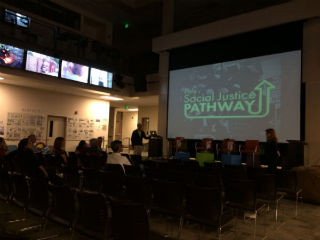With only two months into the implementation of the Social Justice Pathway, Palo Alto High School teachers are satisfied with the progress and direction of the program, according to a presentation on Oct. 15 in the Media Arts Center.

Hosted by the Parent Teacher Student Association, the event included a powerpoint presentation by Social Justice Pathway teachers Eric Bloom and Erin Angell, as well as a question and answer session following the presentation.
The Social Justice Pathway, a three-year program that integrates subject curriculum with community action, made its debut at the beginning of the 2014-15 school year at Paly. It is one of several additions to the course catalog this year.
Bloom and Angell expressed the success of the pathway by sharing a story of experiential learning. Angell recalls a student’s request to walk out of class in the middle of a lesson about power and the concept of having power over someone.
“I thought that it was probably the best way that I’ve ever taught,” Angell said. “It was the first time in Palo Alto where students dared to try something like that. It was invigorating, I thought it was great — it felt very real, [it was] great for me as a teacher, [and it was] very exciting.
Unique features of the pathway include internship opportunities, field trips, experiential learning activities and a Capstone Project, in which students “generate a sustainable plan, execute and reflect on measurable goals,” according to Angell.
One of the goals of the program is to highlight the value students see in their community. Instead of taking advantage of volunteer opportunities for the sake of getting the President’s Service Award, the teachers encourage students to add value to the organization.
“Erin [Angell] and I had a strong sense that we see a difference between the concept of service versus volunteering,” Bloom said. “What we want to acknowledge is that service, from our perspective, is you’re adding value to an organization. We’re trying to get kids to understand that they have value, that they can make value in the community.”
In addition, the grading method of the new pathway differs from traditional types.
“Performance tasks are graded by completion but are evaluated on a scale from emergent, not really meeting the goals of this task, to mastery, that says you really have,” Bloom said. “There’s a third category in our grade book, which is reflection. They [students] reflect on what it was that they did, where their successes were, what they can improve on.”
The Social Justice Pathway approach emphasizes the views of the students.
“What is it that you agree with, what is it that you value, what is it that you offer others — that’s part of the mindset of this [pathway],” Bloom said.

